Alt normal ast high. The Truth About AST Test: Unraveling High, Low & Normal Results, Symptoms & Causes
What is an AST test? How can high, low, and normal AST levels affect your health? Explore the symptoms, causes, and significance of AST test results.
Uncovering the Importance of the AST Test
The AST (aspartate aminotransferase) test is a crucial blood test that provides valuable insights into the health of your liver. This enzyme, found predominantly in the liver but also present in other organs like the muscles, can offer vital clues about potential liver damage or other medical conditions.
Decoding High, Low, and Normal AST Levels
The normal range for AST levels can vary slightly based on factors like age, gender, and medical history. Generally, a normal AST level falls between 10 to 40 units per liter (U/L) for adults. However, it’s important to understand the significance of high or low AST levels:
High AST Levels
Elevated AST levels, typically above 40 U/L, may indicate the presence of liver damage or disease. This could be due to conditions like hepatitis, cirrhosis, or even a heart attack or pancreatitis. It’s crucial to work closely with your healthcare provider to determine the underlying cause and appropriate treatment.
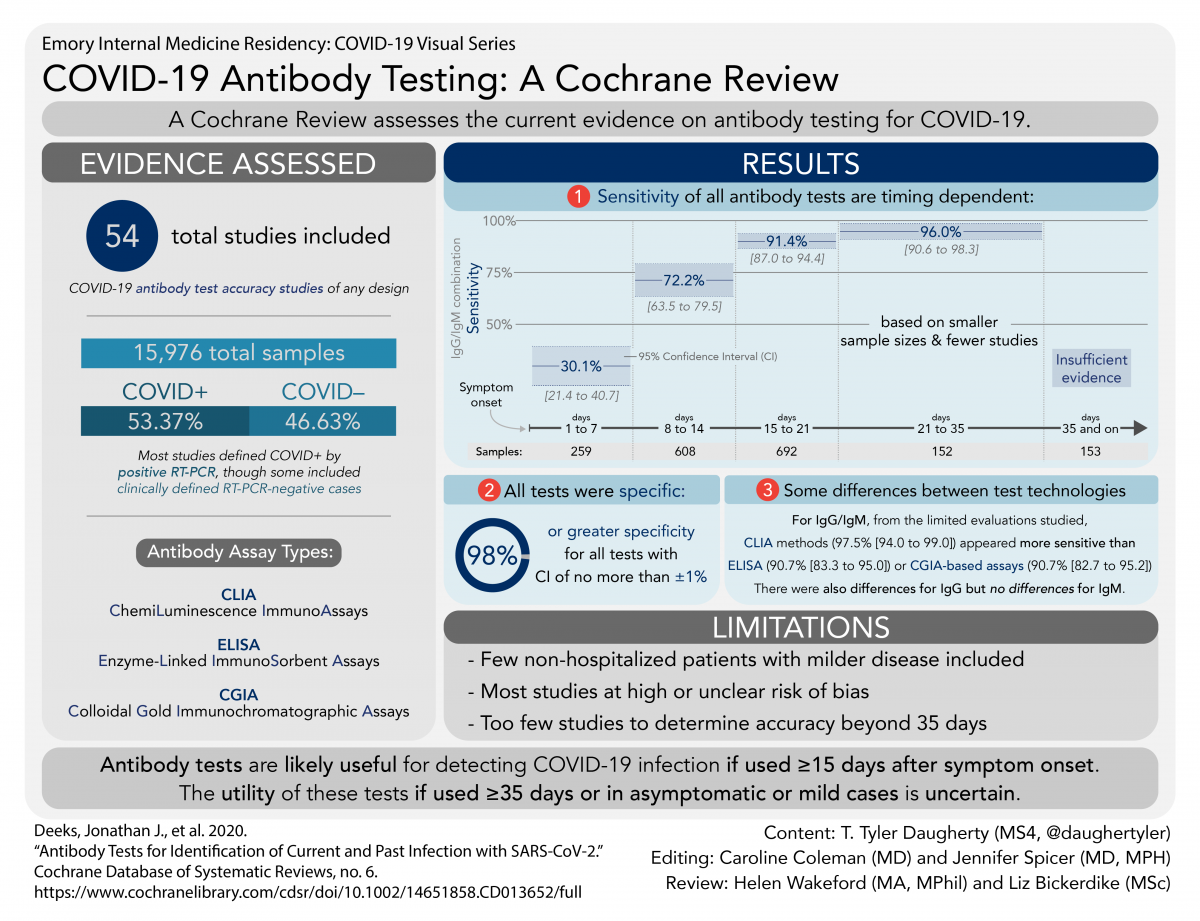
Low AST Levels
Low AST levels, generally below 10 U/L, are less common and may not always signify a health issue. However, they can sometimes be associated with vitamin B6 deficiency, certain genetic disorders, or conditions affecting the liver’s ability to produce enzymes.
Normal AST Levels
When your AST levels fall within the normal range, it suggests that your liver is functioning properly. However, it’s essential to consider the overall picture, as normal AST levels don’t necessarily mean there are no underlying health concerns.
Symptoms Associated with Abnormal AST Levels
Depending on the underlying cause, abnormal AST levels can be accompanied by various symptoms:
Symptoms of High AST Levels
- Nausea and vomiting
- Lack of appetite
- Fatigue and weakness
- Jaundice (yellowing of the skin and eyes)
- Abdominal pain and swelling
- Dark-colored urine and light-colored stool
- Frequent itching
Symptoms of Low AST Levels
Low AST levels are less commonly associated with specific symptoms, as they are often asymptomatic. However, in some cases, they may be linked to:

- Vitamin B6 deficiency-related symptoms like muscle weakness, fatigue, and confusion
- Symptoms of underlying genetic disorders or liver dysfunction
Potential Causes of Abnormal AST Levels
A variety of factors can contribute to high or low AST levels, including:
Causes of High AST Levels
- Liver diseases (e.g., hepatitis, cirrhosis, fatty liver disease)
- Heart problems (e.g., heart attack, heart muscle damage)
- Pancreatitis
- Muscle injury or damage
- Certain medications that can cause liver damage
- Excessive alcohol consumption
- Viral infections (e.g., mononucleosis)
Causes of Low AST Levels
- Vitamin B6 deficiency
- Certain genetic disorders affecting liver enzyme production
- Liver dysfunction or impairment
Interpreting AST Test Results
Understanding the significance of your AST test results is crucial. While high levels may indicate liver damage or other health concerns, it’s essential to work closely with your healthcare provider to determine the underlying cause and develop an appropriate treatment plan. Low AST levels are less common and may require further investigation, particularly if accompanied by other symptoms.

Comprehensive Liver Function Evaluation
AST is often measured as part of a comprehensive liver function panel, which includes other tests like ALT (alanine transaminase) and bilirubin. Your healthcare provider may order these additional tests to gain a more complete understanding of your liver’s overall health and function.
Monitoring and Managing Abnormal AST Levels
If your AST levels are outside the normal range, your healthcare provider may recommend regular monitoring and appropriate interventions to address the underlying cause. This may include lifestyle changes, medication adjustments, or referral to a specialist for further evaluation and treatment.
AST Test: MedlinePlus Medical Test
What is an AST Test?
AST (aspartate aminotransferase) is an enzyme that is found mostly in the liver, but it’s also in muscles and other organs in your body. When cells that contain AST are damaged, they release the AST into your blood. An AST blood test measures the amount of AST in your blood. The test is commonly used to help diagnose liver damage or disease.
Other names: SGOT test, serum glutamic oxaloacetic transaminase test; aspartate transaminase test
What is it used for?
An AST blood test is often part of a routine blood screening to check the health of your liver. The test may help diagnose or monitor liver problems. It may also help diagnose other health conditions.
Why do I need an AST blood test?
You may get an AST blood test as part of your routine checkup or if you have symptoms of liver damage. These may include:
- Nausea and vomiting
- Lack of appetite
- Fatigue
- Weakness
- Jaundice, a condition that causes your skin and eyes to turn yellow
- Swelling and/or pain in your abdomen (belly)
- Swelling in your ankles and legs
- Dark-colored urine (pee) and/or light-colored stool (poop)
- Frequent itching
Even if you don’t have symptoms, your health care provider may order an AST blood test if you’re more likely to develop liver disease because of:
- A family history of liver disease
- Alcohol use disorder
- Obesity
- Diabetes
- Taking certain medicines that can cause liver damage
- Hepatitis or exposure to hepatitis
What happens during an AST blood test?
A health care professional will take a blood sample from a vein in your arm, using a small needle. After the needle is inserted, a small amount of blood will be collected into a test tube or vial. You may feel a little sting when the needle goes in or out. This usually takes less than five minutes.
After the needle is inserted, a small amount of blood will be collected into a test tube or vial. You may feel a little sting when the needle goes in or out. This usually takes less than five minutes.
Will I need to do anything to prepare for the test?
You don’t need any special preparations for an AST blood test. But an AST test is usually ordered with other blood tests. You usually need to fast (not eat or drink) for up to 12 hours before these tests. Your provider will let you know if there are any special instructions to follow.
Are there any risks to the test?
There is very little risk to having a blood test. You may have slight pain or bruising at the spot where the needle was put in, but most symptoms go away quickly.
What do the results mean?
High levels of AST in the blood may be a sign of hepatitis, cirrhosis, mononucleosis, or other liver diseases. High AST levels may also be a sign of heart problems or pancreatitis.
If your results are not in the normal range, it doesn’t always mean that you have a medical condition that needs treatment. Many things can affect your results, such as certain medicines and your age, sex, and diet. To learn what your results mean, talk with your provider.
Many things can affect your results, such as certain medicines and your age, sex, and diet. To learn what your results mean, talk with your provider.
Learn more about laboratory tests, reference ranges, and understanding results.
Is there anything else I need to know about an AST blood test?
Your health care provider may order an ALT blood test with your AST blood test. ALT stands for alanine transaminase, which is another type of liver enzyme. If you have high levels of AST and/or ALT, it may mean that you have some type of liver damage.
You may also have an AST test as part of a group of liver function tests that measure ALT, and other enzymes, proteins, and substances in the liver.
References
- American Liver Foundation. [Internet]. New York: American Liver Foundation; c2017. Diagnosing Liver Disease – Liver Biopsy and Liver Function Tests; [updated 2020 Feb 17; cited 2022 Feb 14]; [about 3 screens]. Available from: https://liverfoundation.
 org/for-patients/about-the-liver/diagnosing-liver-disease/
org/for-patients/about-the-liver/diagnosing-liver-disease/ - Hinkle J, Cheever K. Brunner & Suddarth’s Handbook of Laboratory and Diagnostic Tests. 2nd Ed, Kindle. Philadelphia: Wolters Kluwer Health, Lippincott Williams & Wilkins; c2014. Aspartate Aminotransferase; p. 68–69.
- National Heart, Lung, and Blood Institute [Internet]. Bethesda (MD): U.S. Department of Health and Human Services; Blood Tests; [cited 2022 Feb 14]; [about 15 screens]. Available from: https://www.nhlbi.nih.gov/health-topics/blood-tests
- Testing.com [Internet]. Seattle (WA).: OneCare Media; c2022. Aspartate Aminotransferase: The Test; [modified 2021 Nov 9; cited 2022 Feb 14; [about 14 screens]. Available from: https://www.testing.com/test/aspartate-aminotransferase-ast/
- University of Rochester Medical Center [Internet]. Rochester (NY): University of Rochester Medical Center; c2017. Health Encyclopedia: Aspartate Transaminase; [cited 2017 Mar 13]; [about 2 screens]. Available from: https://www.
 urmc.rochester.edu/encyclopedia/content.aspx?contenttypeid=167&contentid=aspartate_transaminase
urmc.rochester.edu/encyclopedia/content.aspx?contenttypeid=167&contentid=aspartate_transaminase
High and low levels, and what do results mean
An AST blood test measures levels of aspartate aminotransferase (AST) and helps determine liver function. Too much of this enzyme can indicate a problem, such as liver damage.
Aspartate aminotransferase (AST) is an enzyme mostly found in the liver. AST is also present in other parts of the body, including the:
- kidneys
- heart
- muscles
Another name for the AST enzyme is serum glutamic-oxaloacetic transaminase (SGOT).
Most people have low levels of the AST enzyme. Damage to liver cells can cause the release of extra AST into the blood though, leading to higher levels of the enzyme.
After taking a blood test, doctors will classify AST ranges as normal, high, or low. Laboratories may use different testing methods for analyzing samples, so normal ranges can vary between each laboratory.
There is not an exact range for AST levels, as levels can vary among people and still be normal. AST levels can vary depending on factors such as:
- age
- sex
- weight
- race
The measurements for AST levels are typically in units per liter (U/L) or international units per liter (IU/L). On a test result, the laboratory will usually list their specific reference range.
People will need to look at this reference range and discuss with their doctor what their test results mean for them. To understand the results of an AST blood test, a doctor will also look at other enzymes that can indicate a liver problem.
The following table indicates general AST blood test ranges. However, reference ranges can vary slightly among different laboratories.
| Adults | Children | |
|---|---|---|
| Normal | 10–40 IU/L | |
| High | >36 U/L >1,000 U/L are very high levels and may be a sign of liver injury or hepatitis | >40 IU/L which may be a sign of liver inflammation |
Results from an AST blood test can help indicate liver health.
If AST levels are high, it may also be a sign of:
- chronic hepatitis
- damage from alcohol
- cholestasis, a decrease in bile flow
- heart, kidney, bone, or muscle damage
- liver cancers
- liver scarring, known as liver cirrhosis
Very high AST levels are usually a sign of progressing liver damage, often due to acute hepatitis.
Low AST levels may indicate:
- vitamin B6 deficiency
- kidney disease
- liver disease
- cirrhosis
- cancer
- autoimmune conditions
- genetic conditions
A doctor may also test levels of alanine aminotransferase (ALT), another liver enzyme. ALT levels occur in higher concentrations in the liver.
If ALT levels are normal but AST levels are high, it could indicate a health problem outside of the liver, or it may be a sign of alcohol-induced liver damage.
Having high levels of AST and no other signs of a problem is not necessarily a cause for concern. People with normal liver function can have high AST levels, which may be due to:
People with normal liver function can have high AST levels, which may be due to:
- age
- sex
- race
- certain medications
A person should always discuss any medications or health products they take with a doctor.
Doctors primarily use the AST blood test to check for and assess liver problems, usually alongside other liver tests. The AST protein mainly occurs in the liver and heart. With liver damage, AST can leak from the liver into the bloodstream. When this happens, AST levels in the blood will be higher than normal.
AST also occurs in the brain, heart, kidneys, and muscles. If there is damage in any of these areas, AST levels may also increase.
To rule out issues affecting areas outside the liver, doctors may order a check of the second liver enzyme, ALT, at the same time. If both levels are high, it may indicate a problem with a person’s liver. If only AST levels are high, this may indicate a problem with another organ or system.
People may have an AST test for screening, diagnosis, or monitoring purposes. A doctor may recommend this test if a person:
- has risk factors for liver disease, such as family history, obesity, or diabetes
- has symptoms of a liver problem, such as jaundice, fatigue, or unexplained weight loss
- is undergoing treatment for a liver condition, as an AST blood test can help show how well treatment is working
Alanine aminotransferase (ALT) is an enzyme that mostly occurs in the liver. If there is damage to liver cells, ALT levels in the bloodstream can increase. An ALT test can help indicate liver health, along with other liver enzyme tests.
Healthcare professionals may use both ALT and AST tests to check for the presence of liver enzymes in the blood, as this can give them a clearer idea of overall liver function and health.
Learn more about the ALT test here.
The AST blood test is straightforward and similar to any other blood test. A healthcare professional may take the following steps:
A healthcare professional may take the following steps:
- sit the person down and tie a stretchy band around the upper arm to increase blood flow to that area
- clean the site of the blood draw with an antiseptic wipe
- insert a needle into a vein in the arm to take a blood sample, which may cause people to feel a mild prick or pain
- remove the needle once they have drawn enough blood
- send the blood sample to a laboratory for testing
An AST blood test will usually only take a few minutes in total.
In some cases, people may be able to take an AST test at home. Using an at-home test kit, people will take a blood sample from their fingertip and send the sample to a laboratory. People may receive AST blood test results through the mail, an app, or an online system.
Learn how long it might take to receive blood test results here.
Preparation
People may need to fast for several hours if they are having a combination of liver enzyme tests.
If people are only having an AST blood test, they may not need to fast or prepare in any way.
People will need to let their doctor know if they are taking any medications or supplements, as some may interfere with liver enzyme levels.
As a healthcare professional will be taking blood from the arm, it may be helpful to wear short sleeves during the test.
As with any blood test, an AST blood test has very few risks. It is rare to experience any severe side effects, but people may have some mild bruising or discomfort in the area at the site of the blood draw.
A healthcare professional will place a Band-Aid or bandage on the arm to stop any bleeding.
People may want to have something to eat after the test, particularly if they were fasting beforehand. It is safe for people to drive and continue their usual activities after an AST blood test, unless they experience any unusual symptoms.
A doctor may order tests along with an AST blood test or follow-up tests. This is to help ensure proper diagnosis and determine the best course of treatment. These tests may include:
This is to help ensure proper diagnosis and determine the best course of treatment. These tests may include:
- ALT test: A doctor may order an ALT test alongside an AST test.
- Platelet count: Low platelet levels may indicate HELLP syndrome during pregnancy.
- Coagulation panel: This measures the functioning of clotting-related proteins that the liver produces.
- Complete metabolic panel: This assesses how well the kidneys and liver are working and shows levels of electrolytes.
- Bilirubin test: A bilirubin test checks levels of a byproduct created when the liver breaks down red blood cells.
- Glucose test: High or low blood glucose levels may indicate a liver problem.
- Viral testing: This can help doctors check for hepatitis.
- Imaging: A doctor may order images of the liver via ultrasound.
The extent of follow-up testing will depend on a person’s results.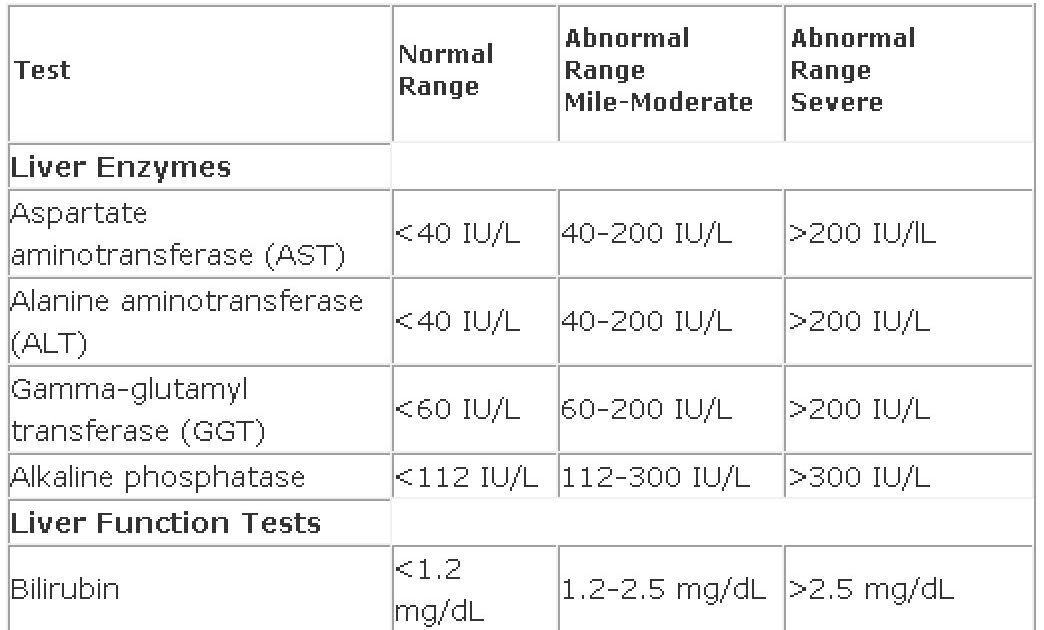 A doctor may also take additional blood tests, imaging tests, or a biopsy to identify or rule out any potential conditions relating to abnormal AST levels.
A doctor may also take additional blood tests, imaging tests, or a biopsy to identify or rule out any potential conditions relating to abnormal AST levels.
Learn about different types of blood tests here.
An AST blood test, or SGOT test, checks how much AST, a liver enzyme, is present in the blood. High levels of AST in the bloodstream could be a sign of liver damage, or cell damage in another organ such as the heart or kidneys.
Doctors may also take additional tests to check other liver enzymes, such as ALT, to get more information on the health of the liver.
When the liver goes wrong: a gastroenterologist named 4 common reasons why ALT and AST are elevated in the blood
- Health
However, the growth of these main “liver” markers in the blood test does not always indicate problems.
April 25, 2022
- Source:
- Getty Images
A biochemical blood test is considered one of the main ways to find out if the liver copes with the load of “wrong” nutrition, alcohol, and medication. This will be told by such indicators in the analysis as ALT (alanine aminotransferase) and AST (aspartate aminotransferase) – these liver enzymes are among the first to respond to malfunctions of the organ.
This will be told by such indicators in the analysis as ALT (alanine aminotransferase) and AST (aspartate aminotransferase) – these liver enzymes are among the first to respond to malfunctions of the organ.
– If there is an increase in both ALT and AST, this means that the liver cells are destroyed and the enzymes from them enter the blood. (…) An increase in AST and ALT means that an inflammatory process is taking place in the liver and its cells are being destroyed. If the indicators are above the norm, you need to contact a gastroenterologist, – gastroenterologist Maria Lopatina wrote in her telegram channel, adding that the upper limits of the norm may differ in different laboratories and one must focus on those established where the analysis was taken.
The doctor named the 4 most common causes of increased liver values.
Chronic viral hepatitis
With an increase in ALT and AST in the blood, viral hepatitis B and C are always excluded first. This is very important, as they can be asymptomatic, while destroying the liver.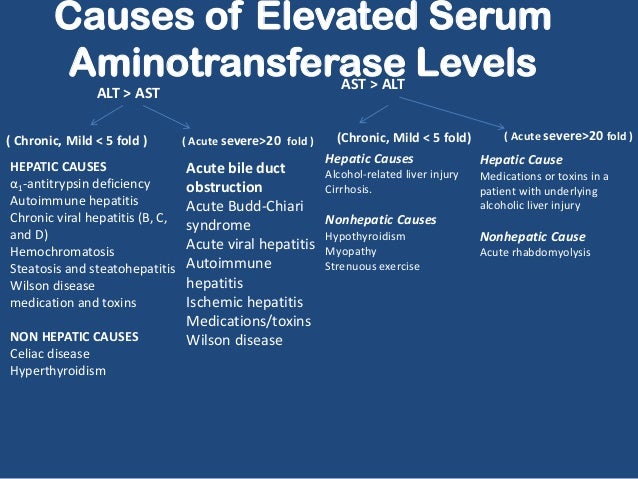 Mandatory tests: HBsAg – hepatitis B and Anti-HCV – hepatitis C.
Mandatory tests: HBsAg – hepatitis B and Anti-HCV – hepatitis C.
Non-alcoholic fatty liver disease
When fatty liver cells destroy them, ALT and AST in the blood rise and steatohepatitis develops.
Fatty liver disease is suspected if:
Waist circumference ≥94/≥80 cm in men/women;
Blood pressure 130/85 mmHg And more, or the person is taking antihypertensive drugs;
Fasting glucose level of 5.6 mmol/l or more, or the person is taking hypoglycemic drugs;
Serum triglycerides more than 1.7 mmol/l;
High-density lipoprotein (HDL) level less than 1.0/1.3 mmol/l in men/women.
Drug-induced liver injury
All drugs that we take by mouth pass through the liver. The more drugs we take, the more likely it is to be damaged. This group includes both herbal preparations and dietary supplements. Liver damage can occur immediately or after several weeks.
Alcohol
According to Russian clinical guidelines, a safe dose for the liver in women is 20 grams of ethanol per day, for men – 40 grams. Regular excess of this dose leads to the development of alcoholic hepatitis and an increase in ALT and AST.
Determining the ethanol content in 100 ml of a drink is very simple: the percentage of alcohol in the drink must be multiplied by 0.8. Thus, 100 ml of 40% vodka contains 40×0.8=32 grams of ethanol, and 100 ml of 12% wine contains 12×0.8=9.6 grams of ethanol.
The doctor specifies that there are other reasons for the increase in ALT and AST in the blood, but these four are the most common.
Read also
When an increase in the indicator is not a cause for alarm
It happens that an increase in the level of “liver” indicators may not be associated with a problem in the work of our main “filter”. According to gastroenterologist Maria Lopatina, this may be the case if only the AST index is elevated.
– AST is found not only in the liver, but also in the heart, muscles, kidneys, brain and pancreas. If AST levels are elevated and ALT is normal, causes that are not related to damage to liver cells should be ruled out. For example, active training for all muscle groups, the doctor clarifies.
But if the liver values were below normal in the blood test, in most cases this is not a cause for serious concern. According to the gastroenterologist, a decrease in their level can occur during pregnancy, starvation and a reduced content of vitamin B6.
What other indicators of a blood test can be used to understand that something is wrong with the liver, read HERE.
Signs of liver problems that can be seen in the mirror
According to doctors, the liver does not hurt in the usual sense of the word, especially at first – specific symptoms of the disease appear when things have gone too far. As the head of the MIBS outpatient department, gastroenterologist Iyri Alaya said, liver diseases are often accompanied by various digestive disorders:
Increased flatulence;
Feeling of fullness in the stomach;
Rapid satiety after eating;
Loss of appetite;
Dryness and bitterness in the mouth;
Attacks of nausea and vomiting;
Constipation or diarrhoea.

And the most famous sign of liver problems is yellowness of the skin, mucous membranes and sclera, which indicates an increase in the level of bilirubin (bile pigment) in the blood.
Text author: Anastasia Romanova
Read today
Personal experience: how to lower cholesterol by 35% without pills
Reduce cholesterol and save from blood clots: 6 spices that every housewife should have stagnation : a vegetologist explained who suffers from stuffiness intolerance
These vitamins are recommended for women over 40 — the opinion of the gynecologist Volkova
“There is a risk of bleeding”: doctor Krasikova explained who should not take omega-3 supplements
By what blood test indicators can you understand that your liver is on the verge of failure
- Health
Doctors call our main filter organ “silent”: even if the liver is not all right, it will not get sick.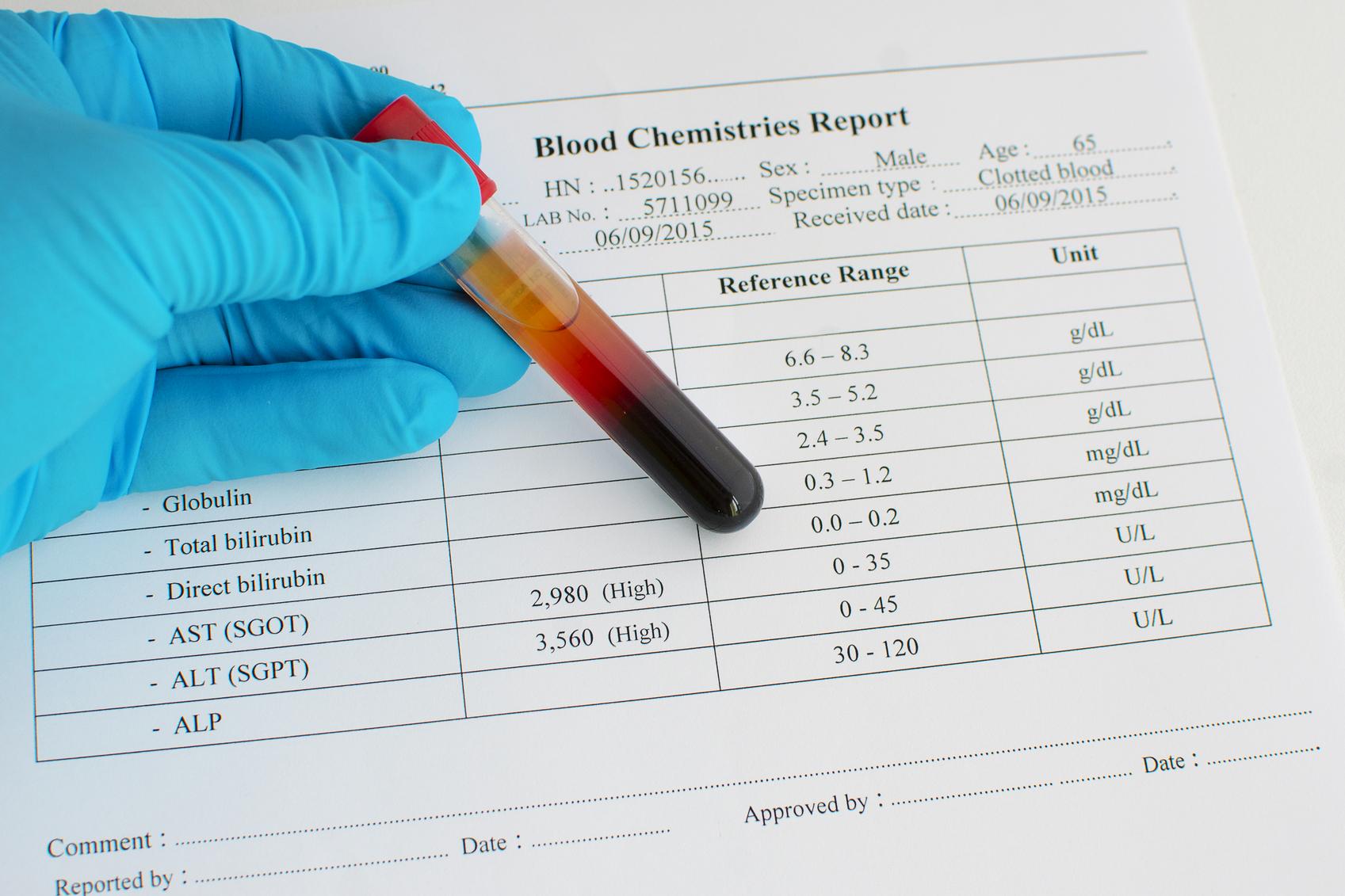 Some pathologies can develop over the years, and if they are not detected in time, the consequences can be very deplorable.
Some pathologies can develop over the years, and if they are not detected in time, the consequences can be very deplorable.
April 18, 2022
- Source:
- Getty Images
The liver is called the main filter organ for a reason: after all, everything that enters our body is absorbed into the bloodstream, and then it passes through the filtration in the liver. Therefore, like no other body, it feels all the consequences of our wrong lifestyle: the habit of eating fatty and high-calorie foods, drinking alcohol, smoking cigarettes. Also, do not forget about the load that the body experiences while taking medications: the liver takes the entire blow from the breakdown of chemical compounds.
Why the liver does not hurt
– This is due to the fact that there are no pain receptors in the liver itself. They are located in the capsule of the liver, which surrounds the organ. When the capsule is stretched due to an increase in the size of the liver itself, this already leads to pain, the doctor explains.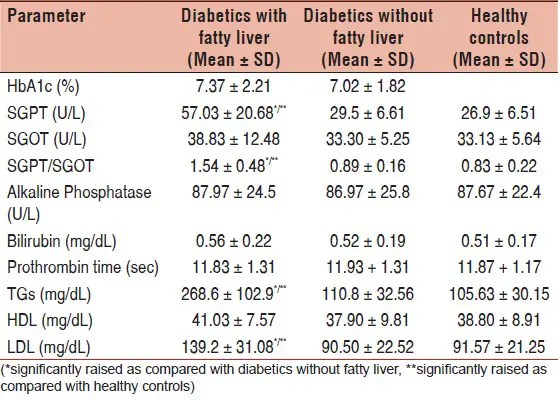
You may experience sudden sharp pain in the liver area due to an injury. For example, this can happen from a strong blow to the stomach. If in this case the capsule ruptures, there is a high probability that internal bleeding will begin.
Sometimes the pain also occurs during physical activity, for example, while running. In people who play sports irregularly, pain in the right hypochondrium is caused by intense filling of the liver with blood – the organ sharply increases in size and the capsule stretches.
Read also
About the most common diseases
– If we talk about the rating, then in the first place I would put fatty degeneration of the liver. With this diagnosis, the organ tissue is replaced by adipose tissue. Many have probably heard about the foie gras dish – this is a goose or duck liver with fatty degeneration, or fatty hepatosis, which is provoked in a bird by a special “diet”. Unfortunately, many people are so accustomed to unhealthy eating that they develop a similar disease, says Maxim Rykov.
If you do not change your menu in time, then fatty degeneration is replaced by what is called the frightening word “cirrhosis”. In this case, the liver tissues are replaced by connective tissue, the organ can no longer fully perform its functions.
Interesting fact
The liver has a very large margin of safety. It can regenerate well, regenerating itself on its own. But until a certain point! With frequent use of alcohol, the safety margin of the liver is enough for about 15 years. For some people, it may take 5-10 years longer, it all depends on the individual characteristics of the body.
But this does not mean, , that all other organs have the same margin of safety, primarily the brain and intestines. They can suffer from alcohol much earlier. Therefore, doctors advise drinking as little as possible, and ideally completely abandoning alcohol.
It is important to mention tumor diseases of the liver.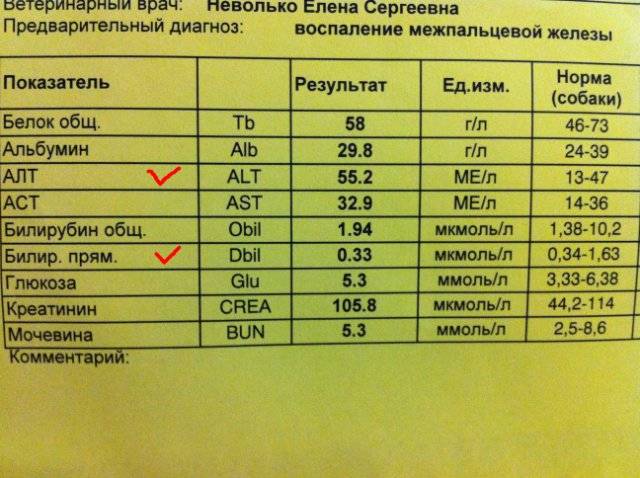
– I mean both metastatic liver damage, when metastases of cancer or tumors appear on it, the primary localization of which falls on another organ, and primary tumors – hepatocellular carcinoma or adenocarcinoma of the liver, which begin to develop directly in the organ.
It should be understood that liver metastasis in malignant tumors is actually an incurable situation. That is, the patient is incurable. With primary liver tumors, the prognosis is also unfavorable; liver and pancreatic cancer are one of the most aggressive forms of cancer. Therefore, it is so important to undergo regular examinations and take tests,” the expert explained.
Not only alcohol and junk food destroy the liver
Many are well aware that the liver suffers from fatty foods, alcohol and frequent medication. However, for some reason, people often forget about cigarettes. Nicotine destroys not only your lungs, but also the liver, because it is absorbed into the blood, and it will inevitably be “driven” through the body’s main filter.
– This is not only about cigarettes, but also about all nicotine-containing products: vapes, electronic cigarettes, sticks, which have been very popular over the past few years. Although they have a lower burning temperature and no smoke, still has a toxic effect on the liver. Moreover, we still do not know how electronic smoking will affect health in 10 or 15 years,” says the doctor.
Read also
How to understand that something is wrong with the liver
Some external signs can sometimes give out problems with the liver:
the skin has acquired a yellowish tint. It can range from pale yellow to bright orange, which is associated with impaired bilirubin metabolism.
The whites of the eyes can also become yellow , mucous membranes can also change color.
– These are the most important indicators, which very often the patient himself does not pay attention to, even when he looks at himself in the mirror. Most often, this is noticed by a person’s relatives or his entourage,” Maxim Rykov explains.
Most often, this is noticed by a person’s relatives or his entourage,” Maxim Rykov explains.
If you notice that your skin or the whites of your eyes have turned yellow, then this is a good reason to make an appointment with a general practitioner or hepatologist.
As for the pain syndrome, unpleasant sensations appear quite rarely. The pain is usually dull, but sometimes more acute, appears in the right hypochondrium, may increase at night. Most often, the increase is explained by the psychological effect of pain perception, since at night, when a person is not busy with any business, is in peace and quiet, the pain is subjectively perceived as more severe, although its true intensity remains the same.
By the way
There is a myth that fasting and drinking warm mineral water helps to cleanse the liver. This is not true. In order for the liver to truly cleanse, a person must fast for 1.5 months, drink only pure water without any additives or drugs.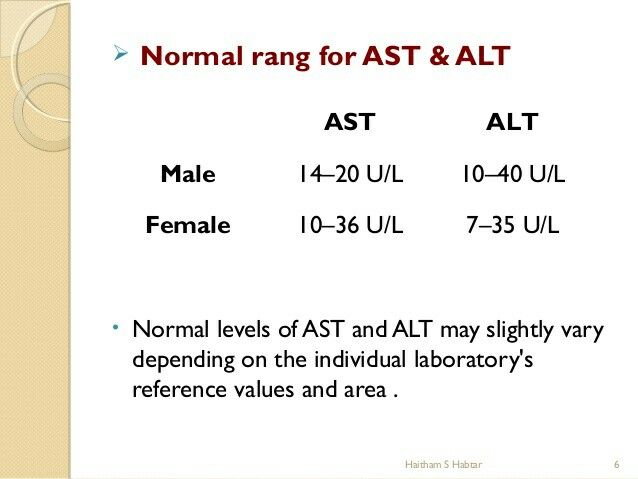 Naturally, this is impossible. Therefore, you need to understand that saving the liver is not in starvation, but in leading a healthy lifestyle, trying to eat right and refrain from alcohol and cigarettes.
Naturally, this is impossible. Therefore, you need to understand that saving the liver is not in starvation, but in leading a healthy lifestyle, trying to eat right and refrain from alcohol and cigarettes.
Many liver diseases can be asymptomatic, so laboratory test results are necessary and informative in the following cases:
you need to check for abnormal liver function;
assessment of severity of liver injury required;
need to monitor the course of liver disease and understand how the treatment is going;
clarification of the diagnosis is required.
– Some biochemical tests are called liver tests. They can measure the amount of enzymes entering the bloodstream or assess liver function by examining hepatobiliary excretion. Other tests are used to assess the synthesizing function of the liver, says Marina Fursova.
Read also
About informative indicators in analyzes
notransferases.
 They are one of the first to react to the fact that the liver undergoes some changes or suffers from frequent alcohol intake. AST and ALT are considered the two most important indicators of liver damage, although ALT is more specific than AST. So, in some cases, AST is directly compared with ALT and their ratio is calculated, which is can clarify why exactly the organ is damaged. Blood AST is also often compared with other tests such as alkaline phosphatase (AP), total protein, and bilirubin to determine a specific form of liver disease;
They are one of the first to react to the fact that the liver undergoes some changes or suffers from frequent alcohol intake. AST and ALT are considered the two most important indicators of liver damage, although ALT is more specific than AST. So, in some cases, AST is directly compared with ALT and their ratio is calculated, which is can clarify why exactly the organ is damaged. Blood AST is also often compared with other tests such as alkaline phosphatase (AP), total protein, and bilirubin to determine a specific form of liver disease;Biochemical blood test for bilirubin. Bilirubin is a bile pigment produced by the breakdown of hemoglobin proteins, aging red blood cells. It is prescribed for liver diseases, violation of the outflow of bile and diseases of the biliary tract, the appearance of yellowness of the eyes and skin. This indicator is gives the doctor an understanding of how a person’s liver works;
Alkaline phosphatase.
 Elevated levels of this hepatocyte enzyme suggest cholestasis , a condition in which bile cannot flow from the liver into the duodenum. The activity of alkaline phosphatase is sometimes increased in healthy people, this does not necessarily indicate any pathology. In order to correctly interpret the change in the activity of alkaline phosphatase, a comprehensive assessment of the results of other tests, as well as other medical data, is needed;
Elevated levels of this hepatocyte enzyme suggest cholestasis , a condition in which bile cannot flow from the liver into the duodenum. The activity of alkaline phosphatase is sometimes increased in healthy people, this does not necessarily indicate any pathology. In order to correctly interpret the change in the activity of alkaline phosphatase, a comprehensive assessment of the results of other tests, as well as other medical data, is needed;Gamma-glutamyl transpeptidase (GGTP) . This is a protein found in the liver and pancreas, its activity in the blood increases with various liver pathologies, as well as with alcohol abuse . It reflects the state of the tissues of the liver and biliary tract;
Prothrombin time (PT) and international normalized ratio (INR) are significant indicators of the ability of the liver to synthesize fibrinogen and vitamin K, on which blood coagulation depends.
 In chronic liver diseases, an increase in INR or PT in indicates progression of liver failure . INR or PV levels do not increase in mild hepatocellular dysfunction and are often normal in cirrhosis;
In chronic liver diseases, an increase in INR or PT in indicates progression of liver failure . INR or PV levels do not increase in mild hepatocellular dysfunction and are often normal in cirrhosis;Whey proteins. Most whey proteins are synthesized by hepatocytes (liver cells) and help in the diagnosis of specific diseases. They also usually rise in response to damage (eg, inflammation) to various tissues, so the rise may be non-specific and unrelated to liver disease.
See also
“In order to diagnose various liver problems, a blood chemistry test is often sufficient. An increase in the level of ALT, AST and bilirubin will indicate that it is time to make an appointment with a hepatologist,” says Maxim Rykov.
Venous blood test must be taken on an empty stomach. 12 hours before donating blood, exclude physical and emotional overstrain, do not smoke for 30 minutes before the test.

 org/for-patients/about-the-liver/diagnosing-liver-disease/
org/for-patients/about-the-liver/diagnosing-liver-disease/ urmc.rochester.edu/encyclopedia/content.aspx?contenttypeid=167&contentid=aspartate_transaminase
urmc.rochester.edu/encyclopedia/content.aspx?contenttypeid=167&contentid=aspartate_transaminase
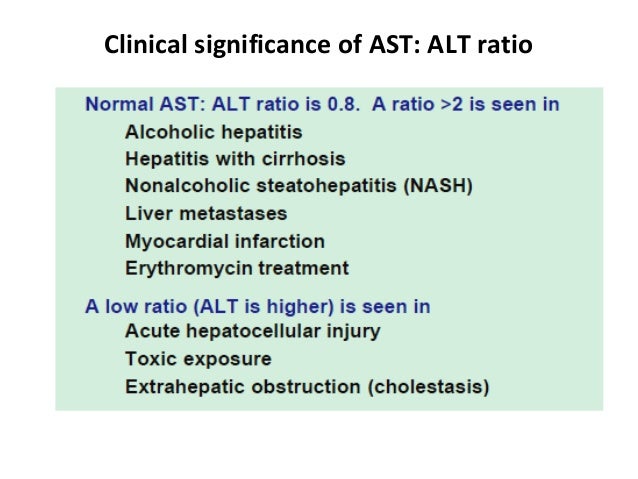 They are one of the first to react to the fact that the liver undergoes some changes or suffers from frequent alcohol intake. AST and ALT are considered the two most important indicators of liver damage, although ALT is more specific than AST. So, in some cases, AST is directly compared with ALT and their ratio is calculated, which is can clarify why exactly the organ is damaged. Blood AST is also often compared with other tests such as alkaline phosphatase (AP), total protein, and bilirubin to determine a specific form of liver disease;
They are one of the first to react to the fact that the liver undergoes some changes or suffers from frequent alcohol intake. AST and ALT are considered the two most important indicators of liver damage, although ALT is more specific than AST. So, in some cases, AST is directly compared with ALT and their ratio is calculated, which is can clarify why exactly the organ is damaged. Blood AST is also often compared with other tests such as alkaline phosphatase (AP), total protein, and bilirubin to determine a specific form of liver disease;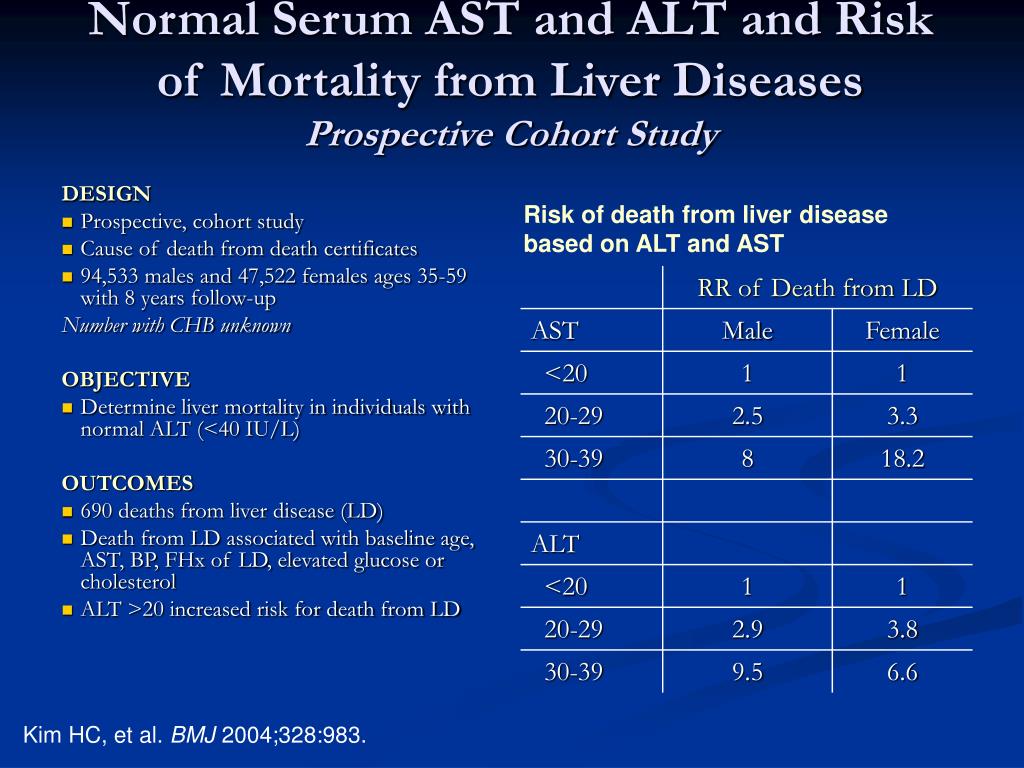 Elevated levels of this hepatocyte enzyme suggest cholestasis , a condition in which bile cannot flow from the liver into the duodenum. The activity of alkaline phosphatase is sometimes increased in healthy people, this does not necessarily indicate any pathology. In order to correctly interpret the change in the activity of alkaline phosphatase, a comprehensive assessment of the results of other tests, as well as other medical data, is needed;
Elevated levels of this hepatocyte enzyme suggest cholestasis , a condition in which bile cannot flow from the liver into the duodenum. The activity of alkaline phosphatase is sometimes increased in healthy people, this does not necessarily indicate any pathology. In order to correctly interpret the change in the activity of alkaline phosphatase, a comprehensive assessment of the results of other tests, as well as other medical data, is needed; In chronic liver diseases, an increase in INR or PT in indicates progression of liver failure . INR or PV levels do not increase in mild hepatocellular dysfunction and are often normal in cirrhosis;
In chronic liver diseases, an increase in INR or PT in indicates progression of liver failure . INR or PV levels do not increase in mild hepatocellular dysfunction and are often normal in cirrhosis;